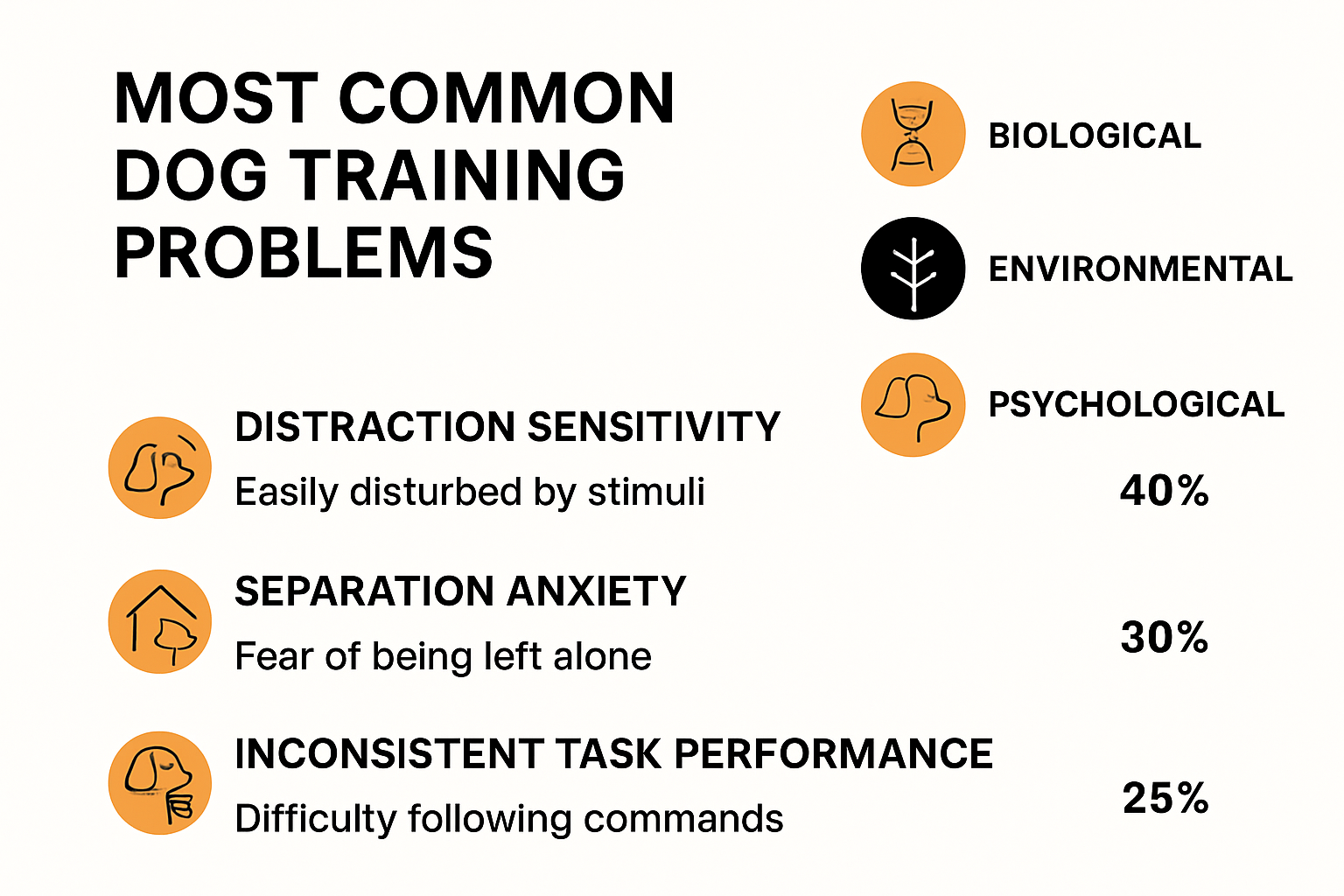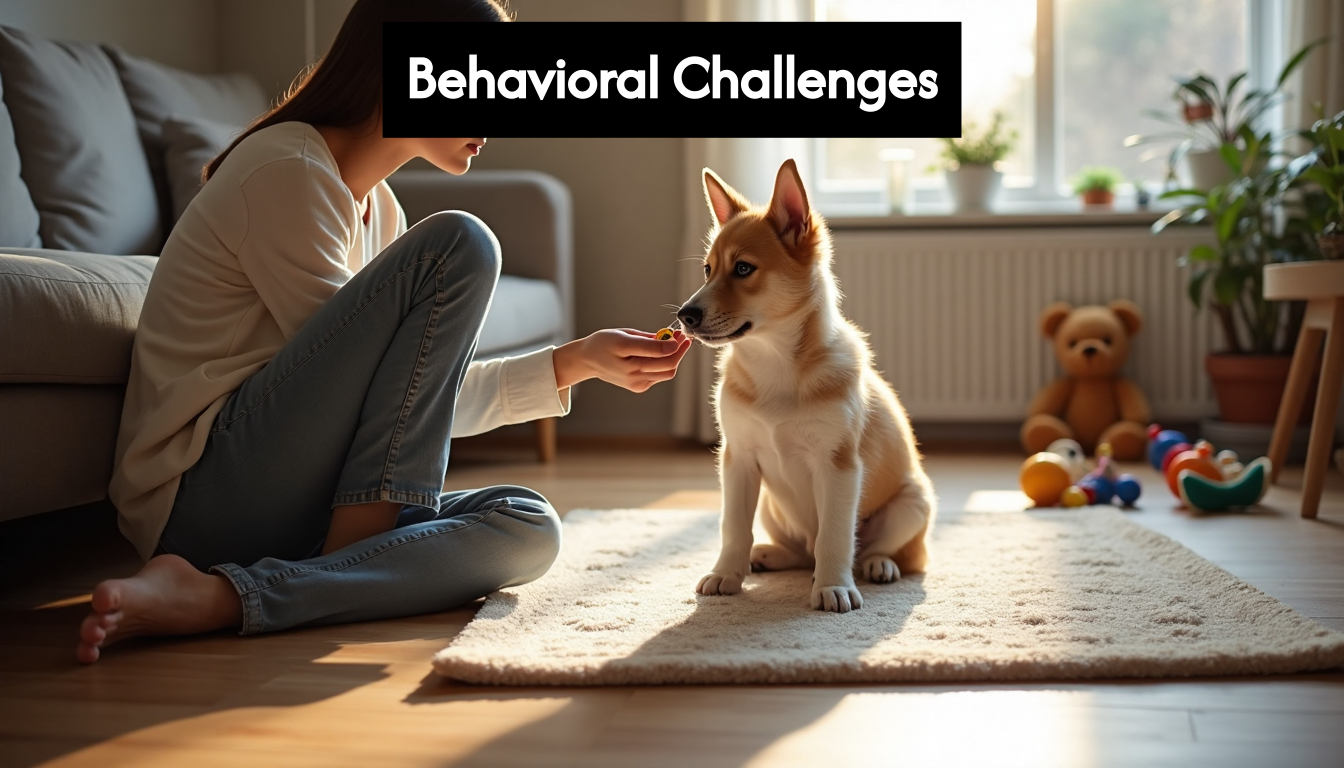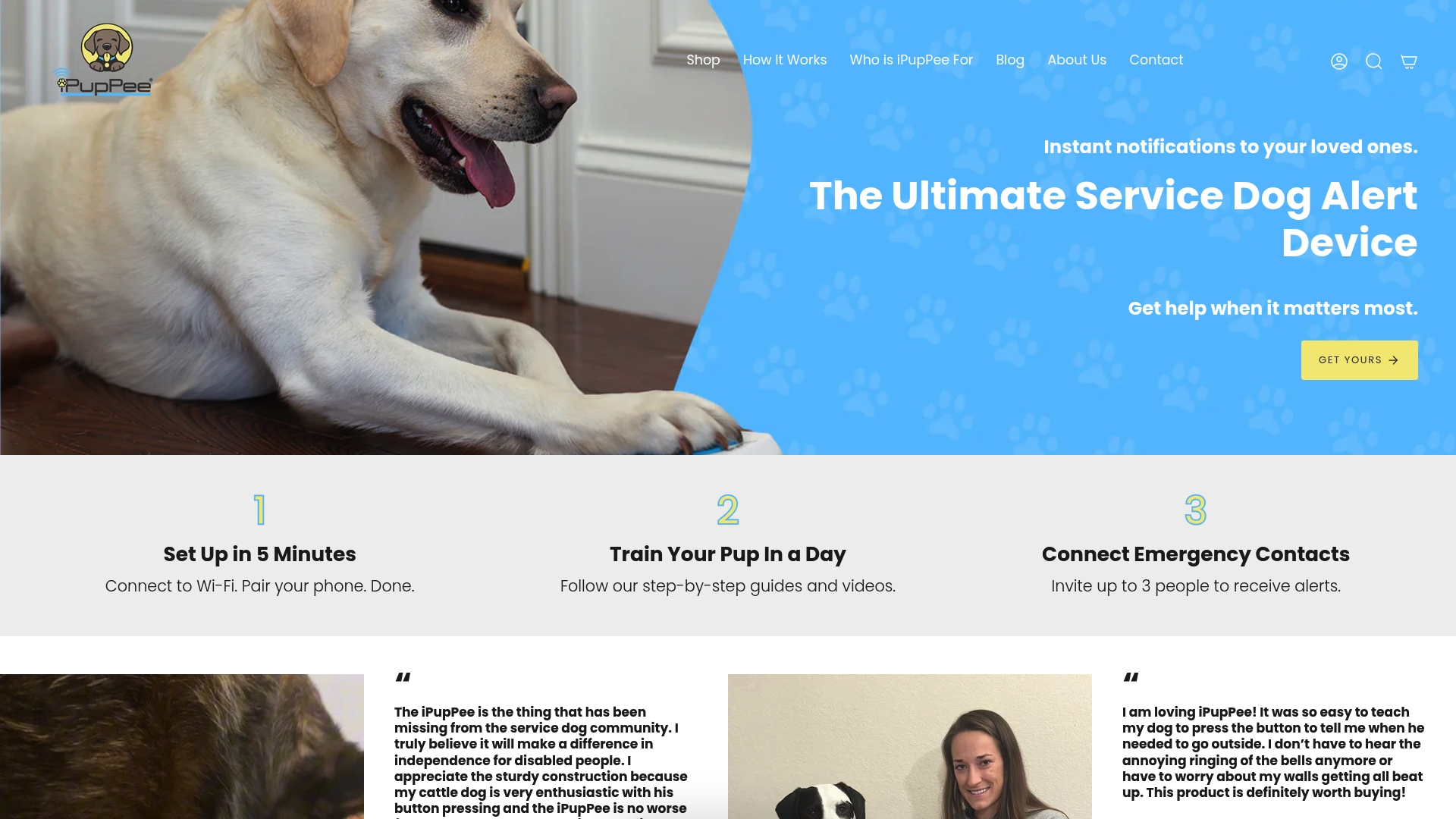
Dog training struggles can take even the most patient owner by surprise. Nearly 99.12 percent of dogs show at least one moderate to serious behavioral issue that makes everyday life more complicated than expected. Most people think the answer is tougher discipline or stricter routines. The real breakthrough happens when you realize that understanding your dog’s emotions and psychological triggers is the key to fixing stubborn problems fast. Here is what actually works in 2025.
Table of Contents
- Understanding Common Dog Training Problems
- Effective Ways To Fix Training Challenges
- Special Solutions For Senior, Rescue, And Service Dogs
- When To Seek Professional Help For Your Dog
Quick Summary
| Takeaway | Explanation |
|---|---|
| Understanding the Root Causes | Training challenges often arise from a mix of biological, environmental, and psychological factors unique to each dog, making tailored approaches essential for success. |
| Emphasizing Positive Reinforcement | Utilizing positive reinforcement methods, such as clicker training and reward-based systems, is the most effective way to encourage desired behaviors and build trust. |
| Identifying Red Flag Behaviors | Certain serious behaviors, including unpredictable aggression and severe anxiety, require immediate professional intervention to ensure safety and effective training. |
| Customized Training Plans | Effective training involves creating individualized training strategies based on comprehensive assessments of the dog’s specific challenges, promoting a more impactful learning experience. |
| Technology in Training | The integration of technology, such as training apps and resources, along with professional guidance, can greatly enhance the training process and outcomes for dogs. |
Understanding Common Dog Training Problems
Dog training challenges are more prevalent than most owners realize. According to research from the Canine Behavior Institute, nearly 99.12% of dogs exhibit at least one moderate to serious behavioral issue, making training a critical aspect of responsible pet ownership.
Root Causes of Training Difficulties
Understanding the underlying factors that contribute to dog training problems is crucial for developing effective solutions. Most training challenges stem from a combination of biological, environmental, and psychological factors. Dogs are complex beings with individual personalities, past experiences, and unique learning styles that significantly impact their ability to learn and respond to training.
Genetic predispositions play a substantial role in a dog’s trainability. Some breeds are naturally more responsive to commands, while others require more patience and specialized approaches. For instance, working dogs like German Shepherds and Border Collies tend to be more receptive to training, whereas independent breeds might present more significant challenges.
Behavioral Challenges in Training
The spectrum of dog training problems is wide and varied. Service dog training statistics reveal that nearly 70% of dogs in professional training programs do not graduate due to specific behavioral challenges. These challenges typically include:
- Distraction Sensitivity: Dogs struggle to maintain focus during training sessions
- Stress Reactivity: Emotional responses that interrupt learning processes
- Inconsistent Task Performance: Difficulty maintaining learned behaviors in different environments
Separation and attachment behaviors represent another significant training hurdle. Research indicates that 86% of dogs experience moderate to serious issues related to emotional attachment and separation anxiety. These problems can manifest as destructive behavior, excessive barking, or extreme distress when left alone.
Effective dog training requires a holistic approach that addresses not just the behavioral symptoms but the underlying emotional and psychological needs of the dog. Owners must recognize that training is not about domination but about building trust, communication, and mutual understanding.
Understanding these complex dynamics is the first step toward developing successful training strategies. By acknowledging the unique characteristics of your dog and approaching training with patience, consistency, and empathy, you can overcome most common training obstacles. Learn more about basic command training techniques to establish a strong foundation for your dog’s behavioral development.


Effective Ways to Fix Training Challenges
Addressing dog training challenges requires a strategic and compassionate approach. Research from the University of Lincoln highlights that targeted training interventions can significantly reduce problematic behaviors, offering hope for dog owners struggling with training difficulties.
Positive Reinforcement Techniques
Positive reinforcement stands out as the most effective training method in 2025. Global training trends indicate that force-free training approaches like clicker training and reward-based systems are now the gold standard for behavioral modification. These techniques focus on encouraging desired behaviors through consistent rewards, creating a supportive learning environment that builds trust and strengthens the human-dog bond.
Key positive reinforcement strategies include:
- Immediate Reward: Provide treats or praise within seconds of the desired behavior
- Consistent Timing: Ensure rewards are given precisely when the dog performs the correct action
- Gradual Complexity: Slowly increase the difficulty of commands as the dog masters basic skills
Personalized Training Approaches
No single training method works for every dog. Successful training requires a personalized approach that considers the individual dog’s breed, personality, age, and previous experiences. Learn more about tailoring training to specific dog skills to develop a more effective training strategy.
Professional dog trainers recommend a multi-step approach:
- Conduct a comprehensive behavioral assessment
- Identify specific training challenges
- Develop a customized training plan
- Implement consistent, patient training techniques
- Regularly adjust the approach based on progress
Technology and Professional Support
Modern dog training has evolved beyond traditional methods. Technology now plays a crucial role in addressing training challenges. Training apps and online resources provide dog owners with expert guidance, interactive learning modules, and progress tracking tools. The 2025 landscape of dog training emphasizes technological integration and professional support.
Owners should consider:
- Professional Consultation: Work with certified dog trainers
- Technology-Assisted Training: Utilize training apps and online resources
- Continuous Learning: Stay updated on the latest training techniques
Successful dog training is a journey of patience, understanding, and consistent effort. By embracing positive reinforcement, personalized approaches, and modern training resources, dog owners can effectively address training challenges and build a stronger, more communicative relationship with their canine companions.
Special Solutions for Senior, Rescue, and Service Dogs
Training dogs with unique backgrounds requires specialized approaches that recognize their individual challenges and capabilities. Global market research indicates the dog training services market is expanding, reflecting the growing need for customized training solutions for diverse canine populations.
Rescue Dogs: Overcoming Traumatic Backgrounds
Rescue dogs often carry emotional and behavioral scars from past experiences, making their training more complex. These dogs require patient, trauma-informed approaches that prioritize building trust and emotional security. Key strategies include creating predictable environments, using gentle positive reinforcement, and avoiding techniques that might trigger previous traumatic memories.
Specialized training for rescue dogs focuses on:
- Emotional Rehabilitation: Gradual confidence building
- Trust Development: Consistent, non-threatening interactions
- Behavioral Reset: Addressing potential anxiety and fear responses
Senior Dogs: Adaptive Training Techniques
Training senior dogs demands a nuanced approach that considers physical limitations and cognitive changes. Veterinary behavioral specialists recommend modified training techniques that accommodate age-related challenges such as reduced mobility, hearing loss, and slower cognitive processing.
Effective training for senior dogs involves:
- Low-Impact Exercises: Gentle, short training sessions
- Mental Stimulation: Cognitive engagement activities
- Patience and Consistency: Slower learning pace
Service Dog Specialized Training
Service dogs require exceptionally rigorous and specialized training to perform critical tasks for individuals with disabilities. Learn more about advanced service dog skill training to understand the complexity of this training process.
Key components of service dog training include:
- Task-Specific Skill Development: Precise performance of assistance tasks
- Environmental Adaptation: Remaining calm in diverse settings
- Handler Communication: Developing intuitive response mechanisms
Training these special dog populations requires more than standard behavioral modification. It demands a holistic approach that considers emotional, physical, and psychological dimensions. Professional trainers with specialized expertise play a crucial role in helping these dogs overcome challenges and reach their full potential.
Understanding that each dog has a unique story is fundamental. Whether working with a rescue dog healing from past trauma, a senior companion adjusting to age-related changes, or a service dog learning complex tasks, the key is compassion, patience, and individualized training strategies.
When to Seek Professional Help for Your Dog
Recognizing when professional intervention is necessary can be crucial in addressing complex dog training challenges. Professional training experts indicate that the rising demand for certified dog trainers reflects a growing understanding among pet owners about the importance of specialized behavioral guidance.
Red Flag Behaviors Requiring Professional Intervention
Some behavioral issues extend beyond typical training challenges and demand expert attention. Warning signs that indicate the need for professional help include persistent aggression, extreme anxiety, uncontrollable reactivity, and behaviors that compromise the safety of the dog, family members, or other animals.
Critical behavioral indicators include:
- Unpredictable Aggression: Sudden aggressive outbursts toward humans or other animals
- Severe Anxiety Responses: Excessive fear or panic in common situations
- Destructive Behaviors: Consistent property destruction beyond normal puppy exploration
- Complex Psychological Patterns: Compulsive behaviors that disrupt daily functioning
Understanding Professional Training Options
Professional trainers offer comprehensive solutions that go beyond standard training techniques. These experts utilize science-backed methodologies, comprehensive behavioral assessments, and customized intervention strategies tailored to each dog’s unique psychological profile.
Professional training typically involves:
- Detailed Behavioral Assessment: Comprehensive evaluation of dog’s psychological state
- Individualized Training Plans: Customized strategies addressing specific challenges
- Long-Term Behavior Modification: Sustainable techniques for lasting change
Selecting the Right Professional Trainer
Choosing a qualified professional is critical. Look for certified trainers with proven credentials, positive references, and demonstrated expertise in addressing specific behavioral challenges. Enhance your understanding of dog safety and behavioral management to make informed decisions about professional training.
Key considerations when selecting a trainer include:
- Certification Credentials: Verifiable professional qualifications
- Positive Training Methodology: Force-free, reward-based approaches
- Specialization: Experience with your dog’s specific behavioral challenges
- Communication Skills: Clear explanation of assessment and intervention strategies
Professional dog training represents an investment in your dog’s psychological well-being and your family’s quality of life. By recognizing when expert intervention is necessary and selecting a qualified professional, you can address complex behavioral challenges effectively and compassionately.
Remember that seeking help is not a sign of failure but a proactive approach to understanding and supporting your dog’s unique needs. The right professional can transform challenging behaviors and help restore harmony to your home.
Frequently Asked Questions
What are common dog training problems in 2025?
Many dogs exhibit behavioral issues including distraction sensitivity, stress reactivity, and separation anxiety. Understanding these challenges is crucial for effective training.
How can I address my dog’s behavioral issues?
Utilizing positive reinforcement techniques, tailored training approaches, and professional support are effective strategies for addressing common dog training challenges.
When should I consider professional dog training?
If your dog displays red flag behaviors such as unpredictable aggression, extreme anxiety, or other severe behavioral issues, seeking professional help is advisable for safety and effective training.
What training techniques are recommended for rescue dogs?
Rescue dogs often require trauma-informed approaches focusing on building trust, creating predictable environments, and utilizing gentle positive reinforcement to help them overcome their past experiences.
Ready for Easier Training and Stronger Communication With Your Dog?
Struggling with distraction issues, anxiety, or trouble getting your dog to respond? You are not alone. Many dog owners in 2025 find themselves frustrated when traditional training falls short, especially when emotional triggers and communication gaps stand in the way. Imagine if you could give your dog a voice and remove confusion during training and daily routines. The article stressed the importance of understanding your dog’s psychological needs and building trust. Now, you can take the next step to real solutions.

Discover how the iPupPee communication device can transform your approach. With just a simple button press, your dog can let you know exactly what they need. This tool is a game changer if you are a service dog owner, new puppy parent, or working with a rescue pup overcoming past trauma. Experience a new level of safety and independence in your home. Visit ipuppee.com for device info, training guides, and real user testimonials. Start bridging the gap between you and your dog today—your peace of mind and your dog’s happiness are just one click away.

